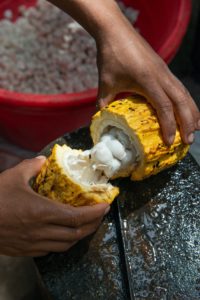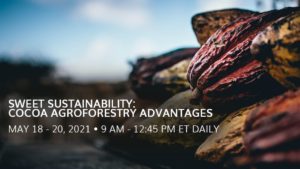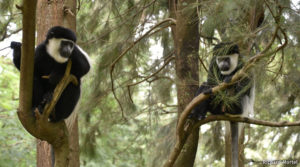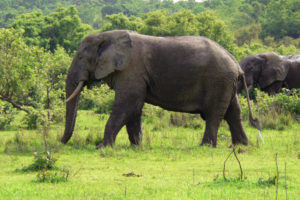COCOA AND DEFORESTATION
The cocoa industry is a major driver of deforestation, loss of critical wildlife habitat, and human rights abuses around the world — particularly in West Africa — but also in Latin America and Southeast Asia.
THE ISSUE
Chocolate comes from the pods that grow on cocoa trees, which are small trees that only grow in the tropics. Cocoa has driven deforestation in nearly every country where it is produced, as rainforests are cut down to make way for cocoa monoculture.
Forest loss* in Côte d’Ivoire and Ghana over the last 60 years:
Côte d’Ivoire
Ghana
* About 1/3 of forest loss in these regions is due to cocoa production.
Did you know?
Côte d’Ivoire (or Ivory Coast) was named after the tusks of thousands of elephants that once roamed the region. Now, only a few hundred elephants survive in the aftermath of habitat destruction and poaching, while chimpanzees and other primate populations have plummeted, with many other species at risk too. Cocoa has driven deforestation in other geographies such as Cameroon, Peru, Ecuador, and Indonesia.
AGROFORESTRY
Much of today’s cocoa is grown in monocropping systems. This agricultural practice involves cultivating a single crop in an area – disrupting food systems for wildlife, people, and organisms in the soil. Monoculture cocoa cultivation is often undertaken with a heavy reliance on harmful pesticides, fungicides, and other chemicals, which leads to pollution of water systems and further endangers wildlife.
Fortunately, cocoa can be grown in ways that promote biodiversity and support healthy ecosystems. For wildlife, the best cocoa comes from shade-grown agroforestry. Agroforestry entails planting cocoa in and among diverse trees and crops. Environmental benefits of this practice include carbon sequestration, soil health, nitrogen fixation, water regulation, erosion control, microclimate control, and increased biodiversity. Agroforestry cocoa systems can help farmers as well, by facilitating income diversification and improving food security.

SOCIAL CHALLENGES
Environmental harms proliferate in the cocoa industry and are often intertwined with human rights abuses and social challenges. Most cocoa farmers already make less than a dollar a day – and many female cocoa farmers make only around 30 cents a day – because the price of cocoa has fallen so low. This sinks them into grinding poverty that makes farmers unable to afford farm improvements to develop complex, robust agroforestry systems. This also makes farmers vulnerable to collude with illegal loggers and poachers in exchange for food or money. The same desperate poverty of cocoa farmers that underlies environmental destruction also helps explain why so many farmers have children working on the farms. Around two million children are thought to work on cocoa plantations. Unfortunately, poverty and child labor are not the only human rights concerns tied to cocoa production. Human trafficking and modern slavery are also a grim reality.
Thankfully, the pace of cocoa reforms has accelerated remarkably in the last four years and there is hope for the possibility of earth-friendly chocolate to become the new normal, though much remains to be done.
WHAT WE DO
Monitoring work:
- Cocoa can be grown without exploitation or deforestation. One of the best ways to ensure deforestation-free production is through satellite mapping and monitoring systems, which the National Wildlife Federation is working on. Previously, NWF and Vivid Economics led a civil society workshop on the Do’s and Don’ts for effective monitoring of deforestation for cocoa worldwide in Poland at the 2018 COP.
- We are kicking off a collaboration with leading researchers, government authorities, and other stakeholders to assess the effectiveness of – and help strengthen – monitoring of Ivorian cocoa and of deforestation, as well as greenhouse gas emissions from this deforestation.
Awareness-raising:
- We raise awareness among our 6 million members and followers about the dangers of deforestation for cocoa, including in our 2018 blog driving members to ask CVS for a change in chocolate sales policy, our 2020 Valentine’s Day consumer campaign, our 2021 Valentine’s Day blog, green living guides, and more.
Assessing companies:
- We work with a consortium of non-governmental organizations to assess the largest cocoa and chocolate companies in an Easter Scorecard, looking at their zero-deforestation commitments and implementation in addition to other sustainability metrics such as traceability and agroforestry, as well as human rights issues.
Advising governments:
- We advise European governments on proposed laws to aim for zero-deforestation supply chains for cocoa and other commodities like beef and soy.




